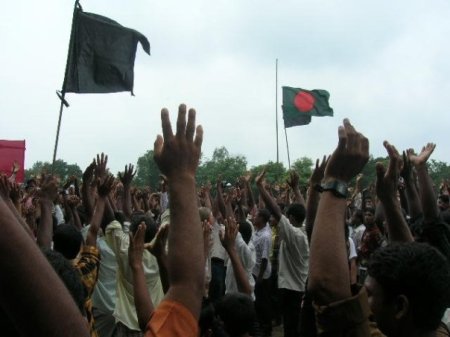By Thalif Deen, Inter Press Service, August 20, 2009
STOCKHOLM, (IPS) – A longstanding quote attributed, rightly or wrongly, to the legendary author and humourist Mark Twain has been reverberating in the conference rooms of the Swedish capital: “Whisky is for drinking, water is for fighting over.”
Since nearly half of the global available surface water is found in 263 international river basins, the countries sharing borders have one of two choices: either collaborate or go to war.
A primary focus at the international water conference, currently underway in Stockholm, is transboundary water management.
The sources of potential collaboration or conflicts include sharing waters in the Baltic Sea, the Jordan River, the Mekong River Basin, the Ganges River, the Indus River and the Nile Valley, among many others.
Gunilla Carlsson, the Swedish minister for international development cooperation, points out that over 60 percent of the world’s population live in river basins that are shared by two or more countries.
“This is something we cannot ignore,” she told delegates. “We have one such water in our very city of Stockholm, the Baltic Sea. Its waves of history are filled with war and conflict, as well as with peace and cooperation.”
Carlsson also said transboundary water issues not only concern rivers or river basins, which require political and technical solutions between bordering nations, but also coastal areas and oceans, where no bordering nations exists.
According to the United Nations, more than 880 million people worldwide still do not have access to safe drinking water.
But there are some water experts, mostly pessimists, who predict that future military conflicts will be fought over scarce water resources.
U.N. Secretary-General Ban Ki-moon admits that even though there is concern over the possibility of “violent disputes” over sharing limited water resources, cooperation is the most common response by people facing competing demands.
He buttresses his argument by pointing out that there are at least 300 international water agreements worldwide, often among parties that are otherwise at odds.
“These agreements demonstrate the potential of shared water resources to foster trust and promote peace,” he says.
In South Asia alone, three transboundary river basins sustain about half of the region’s 1.5 billion people, including some of the world’s poorest.
The three river basins that cover eight countries in the region include: the Ganges-Brahmaputra-Meghna (which spans Bangladesh, Bhutan, China, India and Nepal); the Indus river basin (Afghanistan, China, India, Nepal and Pakistan); and the Helmand river basin (which covers Afghanistan, Iran and Pakistan).
Munqeth Mehyar, chairperson, Friends of the Earth Middle East, told reporters that of the 1.3 billion cubic metres that would flow to replenish the Dead Sea, 100 million cubic metres is all that is left.
The river has seen over 95 percent of its waters diverted. The governments of Israel, Palestine and Jordan have signed agreements to restore the river. But these statements have yet to be followed up by any action, he added.
Mehyar, a national of Jordan, said Palestinians must get direct access to the river and Palestine deserves a share of the water as an equal riparian.
The budget for sustaining conflict and supporting wars is very large. But peace and restoration activities will only require a very small percentage of that budget, he added.
Meanwhile, in a new study released here, the Stockholm International Water Institute (SIWI) says the response of the international water community to the mounting challenges and pressure placed on shared waters has thus far been “inconsistent and inadequate”.
Generally, the international water community is split into three camps over how transboundary flows relate to livelihoods, development and human, state and regional security.
Some emphasise the causal relationships between water scarcity (or floods) and violent conflict or poverty.
Others contend that the evidence of cooperation that exists globally suggests a comforting trend towards stability and wealth.
The third camp is between the two, but stresses the existence of numerous water conflicts that fall short of violence, says the study jointly authored and edited by Dr Anders Jagerskog, programme director at SIWI, Dr. Mark Zeitoun, senior lecturer at the University of East Anglia in Britain, and Anders Berntell, executive director SIWI.
“It seems obvious. Transboundary waters are highly political. And politics are ruled by power,” the authors argue.
Yet, traditional and emerging forms of interaction in the Mekong, Jordan, Ganges, the Nile and in so many other transboundary waterways reveal that the international community turns a blind eye to the power plays over water.
At the same time, too many have silently submitted to the notion that more equitable, sustainable and efficient transboundary water cooperation is not possible, says the study titled “Getting Transboundary Water Right: Theory and Practice for Effective Cooperation”.
In many transboundary water contexts, political power is asymmetrically distributed.
The most powerful riparian state is often able to determine the outcome of the interactions – for unilateral or collective good.
China’s financial assistance to Cambodia in sectors unrelated to the Mekong has been credited for ensuring official Cambodian acquiescence to the building of potentially devastating upstream dams.
Such use of “carrots” to induce cooperation is more welcome than the use of the “stick”, the study says.
Under this unilateral paradigm, however, states can resort to threats and coerce their neighbours to submit to an agreement whose terms may return to haunt them.
And by limiting the exploration of options, the strong-arming can also prevent the creation of a more sustainable agreement based on meeting common interests.




 Posted by zk
Posted by zk